Acoustic Amps:
Ultrasound AG-30
Ultrasound is a relatively small but focused Midwestern US electronics company (based in West Des Moines, Iowa) that started in contract electronic marketing in the mid 1980's. Company designer Greg Farres joined up in 1991 bringing his stripes earned in the sound amplification business to create the first Ultrasound amp; his prime directive was to create a truly authentic amp capable of perfectly replicating a true unamplified tonal character out of a speaker. His first amp, the AG-50 is still widely popular in jazz, folk, and contemporary Christian circles and has since expanded into 100 watt stage model and DI plus direct box.
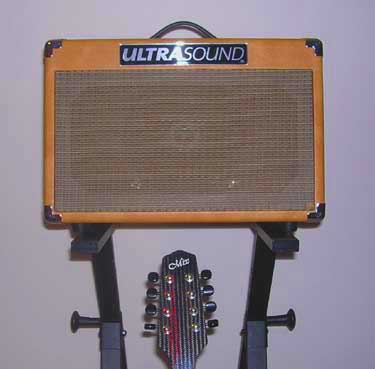
We started our quest of reviewing and offering recommendations, with a very basic truth. There are a large number of amplifiers, a considerable amount of applications, and as many good choices. Though the basic thrust is to narrow our reports on acoustic mandolin (we'll save the electric for another project), we have to take into consideration a huge number of "contexts." The church Praise team contemporary instrumentalist midst the Psalms "clanging cymbal" (let alone Marshall stack of the guitarist) is going to have a whole different requirement for power and tone than the wallpaper guitar/mandolin coffeehouse duo. An amp "wrong" for one will work perfectly well for the other.
Carefully weigh the unique requirements of individual ensembles and their imitable environments. We'll try to point these out as we go. Further thoughts, read our introductory thoughts on acoustic amp considerations.
In our initial contact with Ultrasound, we'd ask for an amp that would be more stage monitor than club amp. We were persuaded to audition the new 100 watt model (and no doubt we will some day), but we were attracted to the more Spartan power needs of a 30 watt amp, bare bones EQ, lightweight, and no-frills plug-and-play tone. The AG-30 met these needs perfectly.
Our motivation for a small amp was admittedly ergonomic; at a mere 20 lbs, it is a dream to cart across a long parking lot, let alone laden with instruments, and over-stuffed accessory bag. To the musician under 40 years of age, this may seem a superficial concern, but to those on the other side of this benchmark, we either get weaker or simply smarter in what we expect to lug to practice and performance. The large handle is balanced nicely, but buttons for a shoulder strap would be a nice addition. (Some of the smaller Trace Elliott amps feature these.)
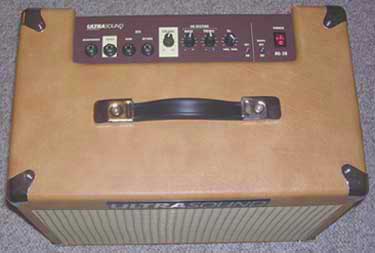
The other requirement was an XLR out. This was intended to be more "reference" monitor than anything, a near-field representation of what would be sent to a board of a house or church system whenever used for larger crowd and/or hall. Many players overestimate the need for a tremendous amount of power; we've often felt it better to keep stage level as quiet as possible and let the soundman control parts of the hall the player will never be able to hear while playing. Plugging an easy-to-carry amp that can accurately represent the acoustic qualities into a house PA through a mic cable (or snake) makes a lot of sense.
On the topic of accurate representation, the AG-30 inarguably shines. We had the opportunity to A/B comparison with a Genz Benz Shenandoah and Roland AC-60, and though both competitive units are commendable and satisfactory, the Ultrasound out of the gate immediately sparkles perceptively with "genuine," rich acoustic sound. Though sparse on EQ controls (only two, high and low bands), the unit required very little in tonal tailoring. One could probably tweak with an outboard EQ unit; we tried alternating outboard with an LR Baggs Para Acoustic DI and a Boss AD-3, but ironically after 20 minutes of experimenting, the best sound was when the only thing between mandolin and amp was an 18-1/2' cable.
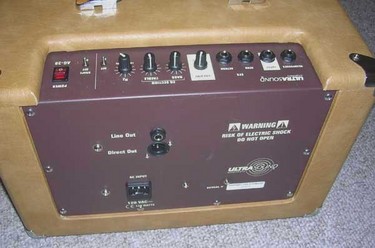
Granted, individual hall environments can demand uniquely different prescriptions for EQ notching, if the unit was only to be a near-field monitor, any other tweaking would only be superfluous fidgeting. The AG-30 front panel does include a modest Notch Filter, and we used this a tad to take some of the woof we get out of the G (octave above the lowest string) on the Mix A5 mandolin (Schertler pickup) we tested with; a resonance we have to tackle in other set-ups. For you geeks, specs report this is a selectable frequency shift of an 18db cut from 100Hz to 350Hz.

Additionally, it features a non-negotiable Shape switch, enabling control over mid frequencies. "On" or "off" selects a pre-set amount of boost on the high and low, cutting the mids. Also included, an Effects Send (unbalanced for pre-tone signal processing or stomp boxes) and Return, as well as the aforementioned XLR or mic out. Though somewhat redundant for a mandolin set-up, a headphone jack disconnects the speaker jack for an electric (or silent) mandolin. Also, no mic input, but that would also be supererogatory on an amp this size.
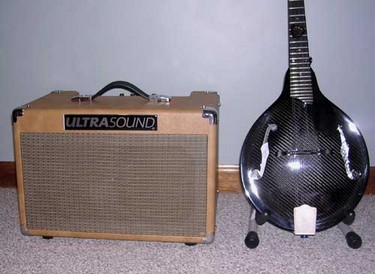
Really, the only thing negative we could say about this amazing amp is its minimal volume capacity. At 80% and up, we experienced some warble on the low G strings while playing loudly. Again, were we looking for something more robust, we would have auditioned the next level up, the AG-50 (and probably will some day), but we need to be clear, this will not likely be a stand alone unit in a room larger than 30' x 30', especially with conversation going on. Five feet from your ear and plugged into a house system, this will do what it is intended.
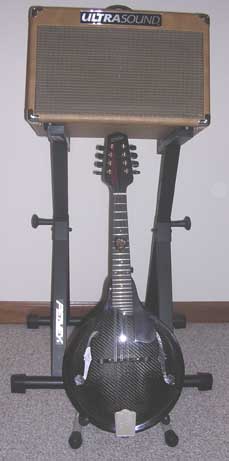
We mentioned the small profile, 11" x 16" x 10-12". It might have been nice to have a recessed stand mount underneath, but at 20 lbs, it's in the awkward size of too heavy for a mic stand, too small for a speaker stand. You will probably want it up off the ground, so if playing while standing, an amp stand or chair is necessary.
Possibly the most amazing feature is its street price. MAP pricing gives you access to a professional studio quality amp, under $200! Competitive units this capable can run as much as double that, and even though they may feature 4-6 bands of EQ and reverb processing, this amp doesn't need it. The sound is there out of the box.
MSRP = $276.00
Street Price = $199.00
Find a dealer.
For more information:
Website: Ultrasound Amplifiers
Email info@ultrasoundamps.com

Disclaimer: In the 'Information Age' of the 21st Century,
any fool with a computer, a modem, and an idea can
become a self-professed 'expert." This site does not
come equipped with 'discernment.'
|



